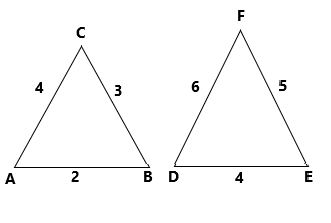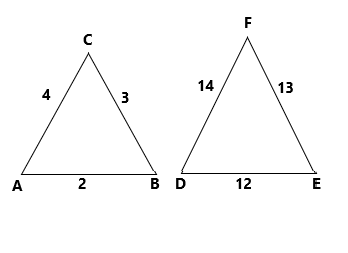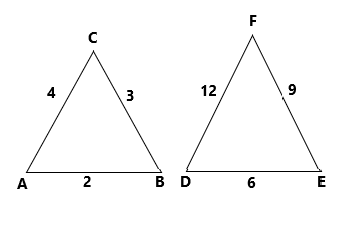
Answer
423.9k+ views
Hint: Here in this question given the sides of the triangle. We have to check or find the similar triangle of given length of triangle and from the given option by using the some conditions for the similarity of two triangles. And observing the triangles we can easily say the similar triangle.
Complete answer:
Triangle is also a polygon. So we have some conditions for the similarity of two triangles. That is: Two triangles are similar, if
their corresponding angles are equal and
their corresponding sides are in the same ratio (or proportion).
if corresponding angles of two triangles are equal, then they are known as equiangular triangles.
A famous Greek mathematician Thales gave an important truth relating to two equiangular triangles which is as follows:
“The ratio of any two corresponding sides in two equiangular triangles is always the same”
i.e., \[\dfrac{{AB}}{{DE}} = \dfrac{{BC}}{{EF}} = \dfrac{{AC}}{{DF}}\]
By using the Thales theorem we can find easily the similar triangle
Consider the given length of the triangle with side 2cm, 3cm, 4cm is:
Option (a) The triangle of length 4, 5 and 6 is comparing with the given triangle of length 2, 3 and 4

By the Thales theorem
\[\dfrac{2}{4} = \dfrac{3}{5} = \dfrac{4}{6}\]
On simplification
\[ \Rightarrow \dfrac{1}{2} \ne \dfrac{3}{5} \ne \dfrac{2}{3}\]
The Thales theorem does not satisfy. hence the option (a) is not correct one
Option (b) The triangle of length 5, 6 and 7 is comparing with the given triangle of length 2, 3 and 4

By the Thales theorem
\[\dfrac{2}{5} = \dfrac{3}{6} = \dfrac{4}{7}\]
On simplification
\[ \Rightarrow \dfrac{2}{5} \ne \dfrac{1}{2} \ne \dfrac{4}{7}\]
The Thales theorem does not satisfy. hence the option (b) is not correct one
Option (c) The triangle of length 12, 13 and 14 is comparing with the given triangle of length 2, 3 and 4

By the Thales theorem
\[\dfrac{2}{{12}} = \dfrac{3}{{13}} = \dfrac{4}{{14}}\]
On simplification
\[ \Rightarrow \dfrac{1}{6} \ne \dfrac{3}{{13}} \ne \dfrac{2}{7}\]
The Thales theorem does not satisfy. hence the option (c) is not correct one
Option (d) The triangle of length 6, 9 and 12 is comparing with the given triangle of length 2, 3 and 4

By the Thales theorem
\[\dfrac{2}{6} = \dfrac{3}{9} = \dfrac{4}{{12}}\]
On simplification
\[ \Rightarrow \dfrac{1}{3} = \dfrac{1}{3} = \dfrac{1}{3}\]
The Thales theorem satisfies. Hence the option (d) is a correct one .
Note:
The condition of a triangle must know that their corresponding angles are equal and their corresponding sides are in the same ratio (or proportion). The Thales theorem is stated on the similar triangles, considering the theorem we have solved the given question and got the solution.
Complete answer:
Triangle is also a polygon. So we have some conditions for the similarity of two triangles. That is: Two triangles are similar, if
their corresponding angles are equal and
their corresponding sides are in the same ratio (or proportion).
if corresponding angles of two triangles are equal, then they are known as equiangular triangles.
A famous Greek mathematician Thales gave an important truth relating to two equiangular triangles which is as follows:
“The ratio of any two corresponding sides in two equiangular triangles is always the same”
i.e., \[\dfrac{{AB}}{{DE}} = \dfrac{{BC}}{{EF}} = \dfrac{{AC}}{{DF}}\]
By using the Thales theorem we can find easily the similar triangle
Consider the given length of the triangle with side 2cm, 3cm, 4cm is:
Option (a) The triangle of length 4, 5 and 6 is comparing with the given triangle of length 2, 3 and 4

By the Thales theorem
\[\dfrac{2}{4} = \dfrac{3}{5} = \dfrac{4}{6}\]
On simplification
\[ \Rightarrow \dfrac{1}{2} \ne \dfrac{3}{5} \ne \dfrac{2}{3}\]
The Thales theorem does not satisfy. hence the option (a) is not correct one
Option (b) The triangle of length 5, 6 and 7 is comparing with the given triangle of length 2, 3 and 4

By the Thales theorem
\[\dfrac{2}{5} = \dfrac{3}{6} = \dfrac{4}{7}\]
On simplification
\[ \Rightarrow \dfrac{2}{5} \ne \dfrac{1}{2} \ne \dfrac{4}{7}\]
The Thales theorem does not satisfy. hence the option (b) is not correct one
Option (c) The triangle of length 12, 13 and 14 is comparing with the given triangle of length 2, 3 and 4

By the Thales theorem
\[\dfrac{2}{{12}} = \dfrac{3}{{13}} = \dfrac{4}{{14}}\]
On simplification
\[ \Rightarrow \dfrac{1}{6} \ne \dfrac{3}{{13}} \ne \dfrac{2}{7}\]
The Thales theorem does not satisfy. hence the option (c) is not correct one
Option (d) The triangle of length 6, 9 and 12 is comparing with the given triangle of length 2, 3 and 4

By the Thales theorem
\[\dfrac{2}{6} = \dfrac{3}{9} = \dfrac{4}{{12}}\]
On simplification
\[ \Rightarrow \dfrac{1}{3} = \dfrac{1}{3} = \dfrac{1}{3}\]
The Thales theorem satisfies. Hence the option (d) is a correct one .
Note:
The condition of a triangle must know that their corresponding angles are equal and their corresponding sides are in the same ratio (or proportion). The Thales theorem is stated on the similar triangles, considering the theorem we have solved the given question and got the solution.
Recently Updated Pages
How is abiogenesis theory disproved experimentally class 12 biology CBSE

What is Biological Magnification

Fill in the blanks with suitable prepositions Break class 10 english CBSE

Fill in the blanks with suitable articles Tribune is class 10 english CBSE

Rearrange the following words and phrases to form a class 10 english CBSE

Select the opposite of the given word Permit aGive class 10 english CBSE

Trending doubts
Name five important trees found in the tropical evergreen class 10 social studies CBSE

The Equation xxx + 2 is Satisfied when x is Equal to Class 10 Maths

Change the following sentences into negative and interrogative class 10 english CBSE

Why is there a time difference of about 5 hours between class 10 social science CBSE

Explain the Treaty of Vienna of 1815 class 10 social science CBSE

Discuss the main reasons for poverty in India




